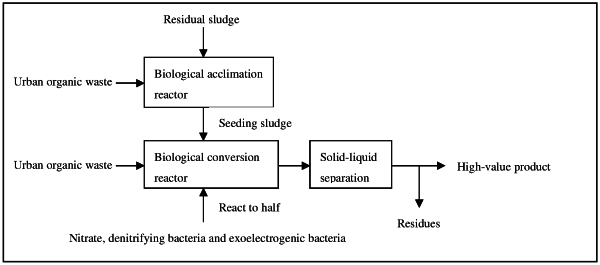| CPC C02F 11/04 (2013.01) [B09B 3/65 (2022.01); C02F 1/66 (2013.01); C02F 11/004 (2013.01); C02F 11/02 (2013.01); C02F 11/147 (2019.01); C12P 7/52 (2013.01); C12P 7/54 (2013.01); C12P 7/56 (2013.01); C12P 39/00 (2013.01); B09B 2101/70 (2022.01); C02F 3/341 (2013.01); C02F 2101/103 (2013.01); C02F 2101/20 (2013.01); C02F 2101/22 (2013.01); C02F 2101/34 (2013.01); C02F 2101/38 (2013.01); C02F 2101/40 (2013.01); C02F 2103/343 (2013.01)] | 10 Claims |

|
1. A method of reducing and controlling a hazardous substance in a process of biological conversion of an urban organic waste, comprising the following steps:
1) Acclimation stage: mixing a sludge, a first urban organic waste and a first organic acid solution with water in a mixture for acclimation to obtain an acclimatized sludge;
2) Stage 1 of biological conversion: mixing the acclimatized sludge with a second urban organic waste to perform anaerobic culture;
3) Stage 2 of biological conversion: adding nitrate and bacteria to continue anaerobic culture so as to obtain a second organic acid solution and a residue;
wherein the mixture has a first amount of the hazardous substance; the second urban organic waste has a second amount of the hazardous substance; the residue has a third amount of the hazardous substance; and wherein the third amount is lower than a total of the first amount and the second amount; and
wherein the hazardous substance comprises at least one of heavy metals and antibiotics.
|